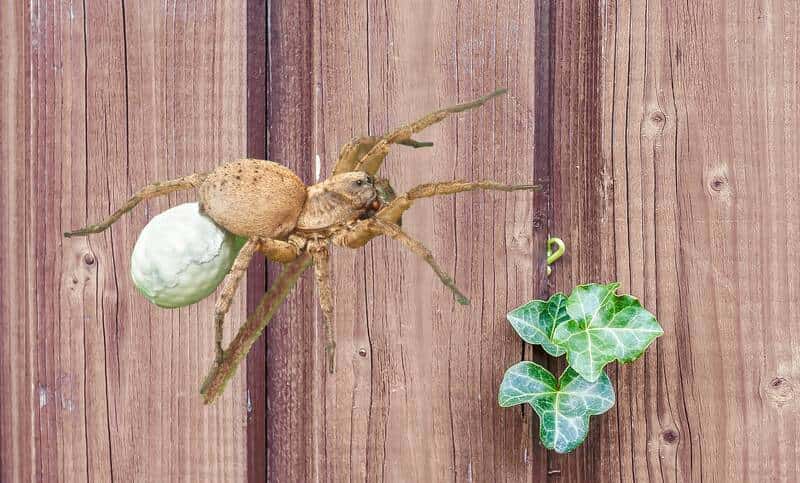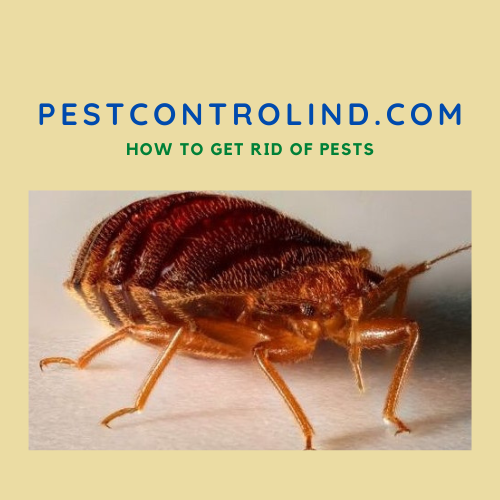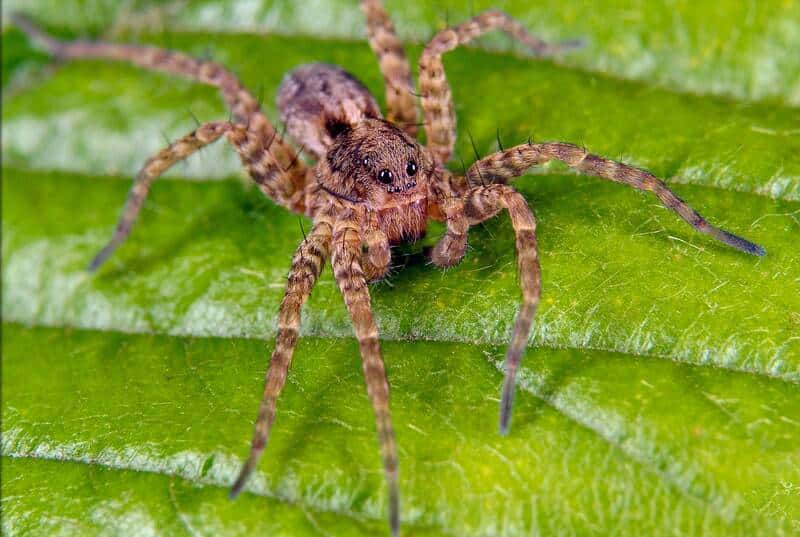In many homes, a pregnant wolf spider can be found. These spiders are members of the Lycosidae family and are well-known for their hunting ability.
They are native to many regions of the world and may frequently be found in gardens, fields, and woodlands.
The reproductive cycle and activities of a pregnant wolf spider will be discussed in this article.
I. What is Wolf Spider
Wolf spiders are part of the Lycosidae family. They are strong and fast spiders that hunt and have exceptional vision. They usually live alone, hunt alone and, unlike other spiders, do not spin a web.
Wolf spiders all have eight black eyes placed around their head, called the cephalothorax.
Two huge eyes protrude from the top of the spider’s head, two more large eyes look forward, and four small eyes form a row directly above the spider’s mouth.
Wolf spiders are usually brown, gray, black, or beige with dark patterns, most often stripes.
Their color serves as good camouflage, allowing them to catch other insects more easily and also to hide from potential predators, such as mice and birds.
Wolf spiders vary in size, with body lengths ranging from about a quarter of an inch to over an inch, not including their legs.
It should be noted that male wolf spiders are considerably larger than female wolf spiders.
II. what does a pregnant wolf spider look like?
A pregnant wolf spider, however, may look very different from a non-pregnant female.
You should know that during pregnancy, a wolf spider’s abdomen will become larger and rounder as the eggs develop.
This is due to the increased size of the eggs and the silk cocoon that surrounds them.
In fact, as the spider gets closer to laying its eggs, its abdomen may become so large that it becomes difficult for it to move easily.
In addition to the changes in size will be seen, the color of the spider’s abdomen may also change.
Some species of wolf spiders have a distinctive pattern on their abdomen that becomes more pronounced when they are pregnant.
This is thought to be a way for the spider to signal to potential predators that it is carrying valuable cargo and should be left alone.
1. how to tell if a wolf spider is pregnant
When a wolf spider is pregnant, it produces a kind of egg sac that contains many eggs.
These egg sacs are smooth and spherical, and they are attached to the abdomen.
If a wolf spider’s abdomen becomes abnormally large, it is more likely that she will soon lay her eggs.
The wolf spider always tries to keep its egg sac above the ground and makes sure it gets enough sunlight each day to facilitate proper incubation.
It also repairs any tears that may appear in the bag.
2. How long are wolf spiders pregnant
Female wolf spiders can usually be seen in midsummer carrying egg sacs, which can range from about 20 to 40 days.
The eggs hatch in the bag in one to two weeks after being laid.
The mother punctures the bag after hatching between 5 to 22 days.
They can sometimes be seen with baby spiders on their backs.
Within the first few hours, the baby spiders emerge from the sac through holes made by the mother, climb onto her abdomen and remain there for a few weeks.
This is because, after mating, the female wolf spider always tries to find a quiet, covered area to lay her eggs.
The females can lay almost 100 eggs each time, which they enclose in a silk bag. The bag is carried by the females on their backs until the eggs hatch.
When the eggs hatch, the female wolf spider breaks the egg sac to release her spiders.
After that, the spiders swarm onto the female’s torso and legs, where they remain for safety.
The baby wolf spiders stay with their mother for a few weeks before dispersing into the wild to begin a new life cycle
They are then ready to fend for themselves.
3. How many babies does a wolf spider have at one time?
The wolf spider will have around 100 spiders for each litter.

III. Are Baby Wolf Spiders Dangerous?
Baby wolf spiders can be found in a house, mainly around windows and other dark places, but since they are harmless to humans, it is possible, if there are only a few of them, to keep them around, especially for insect control!
It is important to know that even adult wolf spiders almost never bite humans. However, it can happen sometimes, if they feel threatened and in most cases their bite is accidental.
Their bite usually disappears after a few days.
Spider bites can cause allergic reactions in some people.
Some symptoms after a spider bite may appear and if you have the following symptoms, seek emergency medical attention:
- Increasing and abnormal swelling of the bite area
- A crimson line extends from the bite, which is also an early indicator of a blood infection.
- Difficulty breathing
- Dizziness and general weakness
IV. Should You Kill a Wolf Spider With Babies?
The ecosystem of life is very fragile and we must save life at all costs if we are not directly threatened.
Killing any living thing, no matter how terrified you are of it, is wrong.
Wolf spiders carrying their offspring, in particular, should not be killed under any circumstances.
And when dealing with an infestation, other solutions should be considered before opting for complete elimination.
And only in the case of an infestation in our home can we opt for direct elimination methods.
V. Are wolf spiders dangerous to babies?
Wolf spiders are common in many homes.
They only bite, as mentioned above, when they feel threatened or provoked, for example when someone tries to handle them.
The bite may be painful, but it is not toxic and will not cause any serious damage.
However, it is important to keep in mind that a baby’s immune system may not be fully developed, which means that he or she could experience an adverse reaction to the bite.
If a baby is bitten by a wolf spider, they may experience the following symptoms:
- Redness and swelling at the bite site
- Pain and discomfort
- Itching and burning
it is important to follow these steps to treat the bite:
- Clean the bite site with soap and water
- Apply a cold compress to reduce swelling and pain
- Give your baby a pain reliever, recommended by a pediatrician
- And if the bite becomes infected, seek medical attention immediately
VI. How to keep wolf spiders out of your home?
To prevent wolf spiders from entering your home, you can follow these tips:
- Keep windows and doors closed when not in use
- Seal cracks and gaps in walls and around windows and doors
- Remove piles of leaves, rocks, and other debris around your home
- Use insecticide sprays around the perimeter of your home
- Try not to leave too much condensation in one part of the house, such as under bathtubs. Because, even if spiders do not drink a lot of water, they like damp corners where they swarm easily.
VII. How to Prevent Pregnant Wolf Spider Infestations in Your Home
Capable of laying hundreds of eggs, a single pregnant wolf spider can bring an army of baby spiders into your home.
Wolf spiders are thus known for their ability to reproduce quickly, which can lead to a major infestation if left unattended.
Prevention Tips for Wolf Spider Infestations
- Seal cracks and gaps: Wolf spiders can enter your home through the smallest of cracks and gaps. To prevent this, make sure to seal any cracks or gaps in your foundation, windows, and doors.
- Keep your home clean: Wolf spiders are attracted to clutter, so keep your home tidy and free of piles of clothes and paper.
- Use spider repellents: There are many natural and chemical spider repellents available on the market that can help keep wolf spiders out of your home.
- Remove hiding places: Wolf spiders like to hide in dark, secluded places, so make sure to remove any potential hiding spots in your home.
- Install screens on windows and doors: Screens on windows and doors can help prevent wolf spiders from entering your home.
VIII. other Questions About Pregnant Wolf Spider
1. Are wolf spiders venomous?
Yes, wolf spiders are venomous, but their venom is not toxic to humans and will not cause serious harm.
2. How to tell if a spider is a wolf spider?
Wolf spiders have long legs and are usually gray, brown, black, or beige with dark brown or black body markings.
Wolf spiders are 1/2 to 2 inches long and are hairy.
The arrangement of a spider’s eyes can help you identify them more easily.
They have eight eyes arranged in three rows.
The top row contains two larger eyes while the bottom row contains four smaller eyes.
The spider also has two small eyes positioned on top of its head.
3. Can a trap be used for pregnant wolf spiders
If and only if it is a large-scale infestation and there is no way to get them out of your house without killing them, then you can use glue traps, which you can later dispose of by throwing them in an outdoor trash can.
This will prevent the eggs from hatching in the same place, in the house garbage can.
4. Should I step on a pregnant spider?
The answer is no. First, it is not at all advisable to kill a spider if it is not dangerous. Secondly, there is a risk of hatching the eggs that the spider carries on its back.
5. pregnant wolf spider jumping distance
Wolf spiders catch their prey mainly by running after it.
However, they will sometimes jump to catch their prey from a distance of up to about 18 cm (7 inches).
Pregnant wolf spiders usually avoid jumping to avoid damaging the egg sac they carry behind their abdomen.
6. Understanding the Habitat of the Pregnant Wolf Spider?
Wolf spiders can be found in a variety of habitats, including forests, fields, deserts, and even urban areas.
These spiders are especially common in North America, where they are found in almost every state.
Pregnant wolf spiders prefer environments that provide plenty of cover and prey, such as tall grass or under rocks.
They are also attracted to areas with high humidity, which helps keep their egg sacs hydrated.
7. Do wolf spider babies eat their mother?
Matriphagia is a term used to describe when juvenile spiders attack their mothers to eat them.
Wolf spiders, on the other hand, do not eat their mothers. When they reach the point where they can survive on their own, they simply disperse into the wild in search of insects to feed on.

